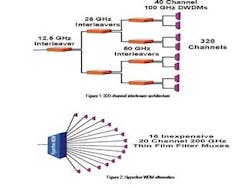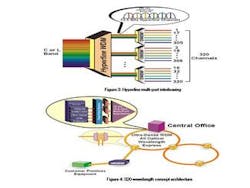Cost-Effective multi-port interleaver for ultra-dense channel counts
How to improve network utilization and increase service revenue without increasing capital expenditure (capex) is the $60,000 question of the day for most carriers. The main choice is between increasing bit rates or increasing channel counts. Since higher speeds appear to have a number of major impacts upon existing networks, ultra-dense WDM appears to be gaining traction. This is confirmed by the 2002 CIR special report, "Why Optical Networking Will Return to Its Roots," which states, "service providers will look to maximize usage of the traditional C-band with narrower channel spacing."
Today's solution for ultra-dense WDM within the C-band is to stack interleavers as shown in Figure 1. The estimated capex for seven interleavers and eight 40-channel DWDM filters--either Arrayed Waveguide Grating (AWG) or Thin Film Filters (TFF)--is approximately $250,000.
Hyperfine WDM: 50% less capex
Hyperfine WDM is a fundamentally different type of multiplexing technology perfectly suited for the narrow channel spacing required for ultra-dense channel counts. This technology is capable of unprecedented channel spacing from 50 GHz to as narrow as 50 MHz.
Figure 2 depicts a hyperfine WDM 320-channel architecture. One 16-channel hyperfine WDM device with 12.5-GHz channel spacing and a 200-GHz Free Spectral Range (FSR) is configured as a multi-port interleaver, multiplexing 320 channels spaced at 12.5 GHz. Instead of using 100-GHz DWDM multiplexers, each hyperfine multi-port interleaver is paired with 16 inexpensive 20-channel TFF devices with 200 GHz spacing. Current prices for these types of devices are $100 per channel. Since these interleaved channels are so narrow compared to the coarse spacing on the attached DWDM device, filter shape is of less importance. This creates a much less expensive and simpler architecture. Additionally, there is a decrease in the cumulative insertion loss, as the insertion loss of a hyperfine WDM device remains constant, whether it has eight or 80 ports.
One multi-port hyperfine WDM interleaver does the job of many standard two-port interleavers. A standard interleaver outputs channels 1, 3, 5, etc. on fiber 1 and channels 2, 4, 6, etc. on fiber 2. As illustrated in Figure 3, with a 16-port hyperfine WDM interleaver, channels 1, 17, 33, etc. are on fiber 1; channels 2, 18, 48, etc. on fiber 2; and so on to channels 16, 32, 48, etc. on fiber 16. Each output fiber contains 12.5-GHz channels spaced by 200 GHz.
This improved architecture costs significantly less (in some cases greater than 50% less), has greater network stability, and offers a much simpler architecture.
New narrowband architectures
With hyperfine WDM, new types of cost-effective architectures are possible such as "virtual OC-768" for the long haul and "wavelength-per-user" for metro/access networks.
One hyperfine WDM with 6.25-GHz spacing can multiplex 16 OC-48 channels into a 100-GHz sub-band of a traditional DWDM system, thereby achieving the same 40-Gbit/sec capacity in the same bandwidth as a single OC-768 channel. This "virtual OC-768" has some compelling advantages compared to the unresolved technical issues of OC-768, including:
• Dispersion: PMD is 256 times less of an issue at 2.5 Gbits/sec than at 40 Gbits/sec.
• Capital Equipment: Other than hyperfine WDM devices and associated light sources, no new equipment is necessary. Erbium doped fiber amplifier (EDFA) placement is unchanged, and regeneration equipment is not needed for the majority of long-haul network spans. The existing installed fiber is adequate. Most of the other equipment is readily available and adequate, including existing test and monitoring equipment.
• Proven Technology: OC-192 and OC-48 system technologies are proven and reliable.
For metro/access networks, hyperfine WDM technology enables all-optical wavelength-per-user architectures.
The metro network of today is comprised of SONET and grooming switches linking the nodes of the network at the central office to long-haul routes. At the edge of the metro core ring is an expensive array of equipment that converts OC-12 and OC-48 to the electrical domain for adding or dropping by an ATM switch or a digital cross-connect system. As traffic lower in the network has changed to higher bandwidths, the task of managing and aggregating bandwidth up to the Central Office (CO) has become more difficult. Rigid architectures with extensive OEO components do not scale well because in SONET-based networks, the service and infrastructure layer are inseparable. As a result, protocols such as Gigabit Ethernet, Fibre Channel, and ESCON cannot be transported without translation to the infrastructure layer. This means expensive adaptations such as IP-over-SONET.
Hyperfine WDM enables many more channels than currently available. This abundance of wavelengths allows carriers to use an optical channel as a "virtual fiber" between the CO and the customer premise. The wavelength-per-user architecture is a much simpler and cost-effective architecture with the following advantages:
• Protocol agnostic: A wavelength doesn't care what protocol it carries. A signal transmitted on a dedicated wavelength between the CO and the Customer Premise equipment (CPE) is carried in its native state. This type of a network design moves many of the complex and costly devices out of the network and into the CO where monitoring, service, and management is easier.
• Centralized equipment: A wavelength between the CO and CPE means that the carrier's switching equipment is located in one or two sites for a metro network. All the devices between the CO and the CPE are passive optical devices that do not require high-level maintenance once the circuit is lit. There is great economy of scale when most of the equipment is in one location. In a distributed network, some COs may be loaded with circuits while others only have a few circuits, but all must have complex equipment. In a wavelength-per-user architecture, the central site chassis grows one circuit card at a time as a new service is sold. Servicing the network is simpler as all of the intelligent equipment is in one or two locations that are already manned with skilled technicians.
• Management of the remote CPE: Management can be accomplished in-band, out-of-band, or with a supervisory channel using standard or proprietary techniques. Because there isn't a mix of protocol specific devices between the CO and the customer, the cost of managing the CPE is significantly reduced. The fiber plant is monitored at the physical level instead of moving up and down through layers two and three.
• Efficient and expanded services: Provisioning of new services or changes in service are simpler. Equipment and spares are stocked in one location. Customer requests for bandwidth turn-up are fulfilled with a simple change order. Value-added services, such as central storage and backup of data or disaster recovery, could be offered with minimal capital expenditure and without a change to the network architecture.
Figure 4 illustrates a hyperfine WDM interleaving architecture for metro/access that uses the same architecture discussed in Figure 2. Using a hyperfine WDM device at 3.125- GHz spacing, this achitecture could distribute 1,280-GbE channels all within the C-band.
Fundamental new technology has a way of radically changing one's perspective. It often turns complex problems into simple solutions. Instead of stacking interleavers, hyperfine WDM technology is a practical and cost-effective path to more efficient bandwidth distribution that minimizes or eliminates many of the obstacles and risky decisions facing today's access network carriers.
Terry Turpin serves as chief technology officer at Essex Corp. (Columbia, MD). For more information, visit the company's Web site at www.essexcorp.com.


